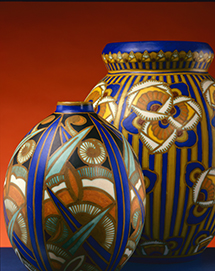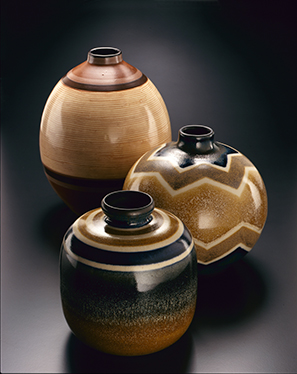The birth of a passion
It all began with a ceramic plate that was discovered quite by chance, but it was a discovery that would lead to the development of a real passion for Claire De Pauw and Marcel Stal. A soldier during World War II, but also an art dealer, Marcel Stal was captivated by the harmoniously rich colours of the plate. The brilliance, simplicity and vividness of the scenes represented reinforced Marcel Stal’s fascination for the work, which had been created by Charles Catteau for Boch Keramis. It was not long before Claire De Pauw would begin to share the same passion.
A natural dichotomy
Initially, the couple collected objects just for themselves. Compared with their other collections, however, Catteau’s works turned out to constitute a very personal and somewhat atypical collection. Whilst the colours evoked their CoBrA art collection, Catteau’s clean lines and strict shapes were more reminiscent of their Art Deco furniture.
Little by little, as their collection grew, so did the collectors’ knowledge. Endlessly travelling the world to look for new pieces, Claire De Pauw and Marcel Stal would visit Catteau’s widow in Nice, or find themselves in a store in Chicago, discovering rare and essential, but horrendously expensive pieces.
Over the years, the collection began to get organised – almost by itself. A natural dichotomy emerged between the works in ceramic and those in stoneware. Whilst Claire DePauw’s interest lay primarily on the earthy colours and somewhat ‘rough’ aspect of the stoneware vases, Marcel Stal preferred the ceramic works, with their more vivid colours and more varied and lively shapes.



An assured future
In the end the couple had collected over 800 pieces, extending to the limits of tradition and modernity and to renewal and nostalgia. Thanks to its diversity, the collection not only magnificently bears witness to Catteau’s work between 1907 and 1948, it also reflects the ambitions of an age, an age when Belgium was enjoying a period of prosperity, both artistically and industrially.
Aware of the importance of this collection for our material heritage, in 1999 Claire De Pauw donated the entire collection to the King Baudouin Foundation. In line with the donor’s wishes, the great majority of the collection has been returned to La Louvière, to the Centre Keramis, where it is now accessible to the general public, and to the former workshop of the Boch Keramis factory. A series of vases is also exhibited at the Royal Museums of Art and History in Brussels. Catteau’s work is now once more accessible to everyone, just like when it was created.